Second part of my report on the C.STEM conference, an event held in Turin last Friday and dedicated to the cultural circulation of generative and procedural systems in the field of experimental digital art. If you speak italian, teknemedia has a report of it as well + some images from the opening (which i didn’t attend as i’m suffering from mundanity-phobia.)
After Marius Watz and Fabio Franchino, Milan-based Alessandro Capozzo gave a brief introduction to some of his rather fascinating works.
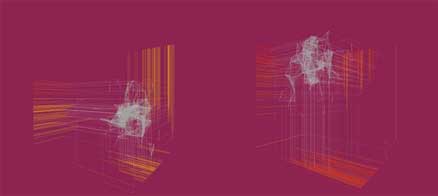 Relations features worm-like shapes that adopt a flocking bahaviour and move in a 3D space. Each creature can be connected with others by an ever-changing net of relations.
Relations features worm-like shapes that adopt a flocking bahaviour and move in a 3D space. Each creature can be connected with others by an ever-changing net of relations.
His Exuvia installation, developed together with Katja Noppes, is inspired by dragonflies and exuvia, the remain of an exoskeleton that is left after an arthropod has moulted.
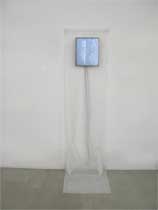
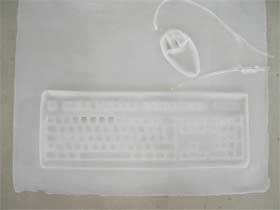
Although in their larval form (a state that can last for years), dragonflies are fierce predators of other larvae and insects, we only notice their existences just when – moulting and leaving their old nature – they live few days in a state of graceful ephemeral euphoria.
Exuvia consists in a semitransparent mould of a desktop computer (connected to its peripherals) and an LCD display with a resin layer mounted on. A dragonfly wings representation was imprinted into the resin by several analogue processes. A semi generative software is visualized on the LCD display: a set of attractors “drive�? a cellular automata flow through wings lines of force. Interaction between an analogue medium and a digital one let some properties of these two elements making a synthesis. The installation suggests a flow starting from a metamorphosis – referred by empty chrysalis (exuvia) as the printed memory of an absent object – till the spreading wings climax: vital, delicate and ephemeral as software could be (video).
Exuvia will be part of the Siggraph art gallery this year.
The last speaker was Paolo Rigamonti from Limiteazero who underlined that their generative art pieces were mainly stimulated by a desire to study the process itself, to see the various modifications it undergoes once the system gets started.
One of the works the Milan-based studio presented at C.Stem are called Three minutes of electronic calculation, Six minutes of electronic calculation, etc. The pieces visualize a simple electronic calculation process based on variations of the circle algorithm. Each piece is a three minutes step freezing of the generative shape.
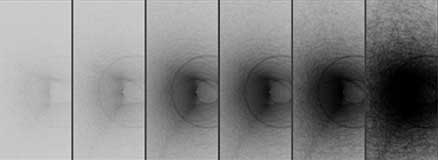
Rigamonti explained that he feels uncomfortable with the label “artist”. He would rather describe himself as an architect who explores architecture of course but also design, software and interactive installations. He certainly doesn’t feel like their work belongs to the activist art that so gloriously marked previous decades. I’m quite sure they’ll want to crucify me for saying this but Paolo Rigamonti and his limiteazero partner, Silvio Mondino, are for me two perfect specimen of new media artists. But then i’d be at a loss if Rigamonti asked me to explain him why (the facts that he’s usually dressed in black and speaks of digital art better than many experts are probably very weak reasons to invoke) and to define what exactly is a “new media artist.” The vague and all-inclusive “new media” expression doesn’t make it easy and as Tim Pritlove (who would probably have a good laugh at the idea of being quoted in a post about new media art) says, most of these media are not new anymore. Could we say that the new media artist is someone with enough curiosity to explore and push the boundaries of emerging technologies and with enough taste to add the usual aesthetic ingredient? Or should we leave aside the aesthetic element? What is sure is that many of these artists, like Rigamonti, come from non-artistic backgrounds and do not easily relate to the traditional definition of artist, generally limited to people making “fine arts.” There’s certainly much to discuss and criticize about my lame attempt to define new media artists so let’s get back to Paolo Rigamonti’s talk!
He sees people who explore generative art and digital art as being rather humble: they are too busy working on their projects to talk about it. According to him, digital art is still in its prehistoric phase if we compare it to thousands of years of art elaborated with pigments and brushes. He also feels that there’s a component of “recycling” in digital art: its practitioners are using as a medium the computer, an instrument that wasn’t conceived to make art in the first place.
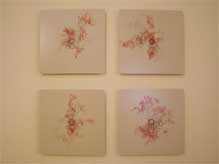
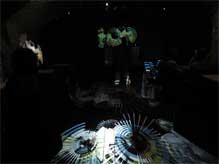 Alessandro Capozzo’s Clusters prints and Marius Watz’ ElectroPlastique #2 at AB+
Alessandro Capozzo’s Clusters prints and Marius Watz’ ElectroPlastique #2 at AB+
The exhibition of C.Stem held in the 32 Dicembre location, will move to the art gallery Allegretti Contemporanea in Turin from June, 23 to the end of July. There will involve a new opening since the exhibit will also showcase the screening of the software which had generated the printed artworks, shown on June, 1. Check the C.Stem blog to keep up with the latest news. Marius Watz has uploaded on flickr several images from the event and Domenico Quaranta has made available online his introduction for the C.Stem catalogue.
